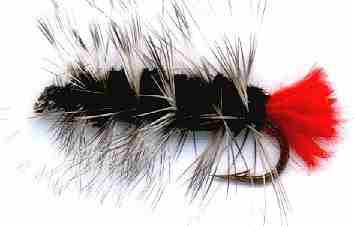Black Woolly Worm Caddis Larva
The Woolly Worm fly pattern is designed to imitate the larval stage of a caddis as it crawls around the bottom of lakes and rivers. Trout and Grayling find these grubs good to eat. This is why this fly pattern is a good fish producer.

WOOLLY WORM FLY PATTERNS. Hook size 10 8 - $US each
THE WOOLLY WORM FLY PATTERN
These palmered flies with short red tails are very popular in America as a good large larval imitation generally categorized as a nymph. It comes in many colors. The palmered hackle gives the impression of movement and causes water vibrations that are detected by predatory trout and salmon. They are ideal for rapid pockets.
Caddis flies at the larval stage protect them selves by building a case. The small red tail tries to simulate the head or legs projecting from the protective case. When birds eat cassed cadis larva they take off the case before eating the lava. Fish cannot do this so eat the larva and the case whole. This explains why you often find pine needles, bits of wood and grains of gravel in the otherwise empty stomach of rainbow and brown trout. Have a selection of different colored woolly worms in your fly box and try to match the color of the materials the local caddis larval worms are using to protect themselves. Fish these flies deep, with short jerks on the line.
Dressing a fly by winding the hackle the length of the body is mentioned in fly fishing books of the fifteenth century. It is called the palmer style of dressing. About the time Napoleon was fighting the British in France and Spain, palmer flies were being praised in books as the first fly to be used until a hatch was observed. The palmered hackle helps suggest to the trout that the fly is alive by its movement.
In New Zealand this fly is used to imitate the 'creeper' (Archichauliodes diversus) the larval form of the Megaloptera insect group. They are more commonly known as the the toe-biter, black fellow or black creeper. The adult winged insects are called Dobson flies, lace-wings or alderflies. In Europe they are used as a good stonefly larva imitation. In America they have also been passed off successfully as the underwater stages of the Caddis fly, Hellgrammite, riffle-beetle or damselfly.
As the British Woolly Worm palmered fly dressing style crossed the Atlantic ocean and prospered in North American rivers its popularity back home nose dived. In the 1930's the West Yellowstone fly fisher Don Martinez started to use it for trout where where previously it had been a bass fly. In his book he suggested that it was used as an attractor lure fished deep and twitched to suggest movement and life. Since then many different variations have been tied. They have been fished as nymphs, streamers and wet flies. Fishermen have used them to imitate damsel fly nymphs, leeches, scuds, stoneflies, caterpillars and cased caddis nymphs. I believe the reason this fly is a champion trout killer is the movement in the hackles. It really attracts the fish. If you are after panfish this would be my choice for rock bass, crappies, blue fish and other sunfish. Give the fly a slow erratic twitch to animate the hackle. If you are a steelhead or sea trout enthusiast give a woolly worm a try, especially the orange attractor pattern. Place it in front of the fish and you might stir up it's aggressive tendencies enough for it to attack.
Fly Fishing books



